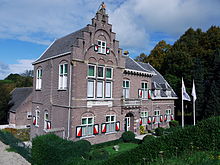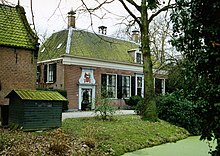Jaarsveld
 flag |
 coat of arms |
| province |
|
| local community |
|
| Residents | 290 (Jan. 1, 2017) |
| Coordinates | 51 ° 58 ′ N , 4 ° 59 ′ E |
| prefix | 0348 |
| Postcodes | 3411, 3413 |
| Website | Homepage of Kattenbroek |
| Location of Jaarsveld in the municipality of Lopik | |

Jaarsveld describes a formerly independent municipality in the Dutch province of Utrecht and the former hoge en vrije Heerlijkheid Jaarsveld .
timeline
The former parish and today's village Jaarsveld emerged from the glory of the same name. The Herrlichkeit Jaarsveld (with Willige Langerak ) were originally owned by Messrs Uten Goye. They and their successors carried the title Heer or Vrijheer van Jaarsveld . In 1327 Jaarsveld went with the manorial seat of Burg Veldenstein with the high jurisdiction to the county of Holland , meanwhile Willige Langerak remained a Utrecht fief. In the 15th century the gentlemen van Arkel owned Jaarsveld. Via their successors, the Lords of Vianen, the glory came to the House of Egmond and in 1518 through the marriage of Anna von Egmond-Buren to William I of Orange-Nassau to the House of Orange . In 1608 Philipp Wilhelm von Oranien-Nassau sold Jaarsveld to the Amsterdam merchant Johan Michielsz van Verlaer. Since the glory was bound to Holland and Utrecht, Simon van Alteren finally brought it under the suzerainty of Holland in 1640 against the protests of Utrecht. In 1673 the Veldenstein Castle was devastated by French troops. The small country house Huis te Jaarsveld was then built by the owners at the time, Mr Van Voorst tot Voorst and De Graeff . In the 18th century Jaarsveld belonged to the De Witts . Under her rule, the mid-century grandeur numbered 195 houses and 1,020 acres .
In 1795, when the Batavian Republic was proclaimed , all glorious rights were revoked. In 1805 the glory of Jaarsveld returned to Utrecht, where it remained until the previous end of the glories in 1923 and beyond. The population from 1840 was 1,079 inhabitants which were distributed over 148. A hundred years later Jaarsveld had 1,412 residents in 338 houses and 1,307 hectares of land. In 1943 Jaarsveld had lost its independence and was incorporated into the Lopik municipality. Between the years 1937-1970 a professional mini golf tournament was held in Jaarsveld in Middengolfzender Jaarsveld . In 2001 the center of Jaarsveld had 248 inhabitants and 83 houses on an area of 0.07 km². Including the peripheral settlements, Jaarsveld has about 330 inhabitants.
Jaarsveld Reformed Church
The foundation of the church dates back to the 14th century, from which the nave is still today . Today's appearance with the sturdy gates and choir dates from around 1500. The interior includes the tombs from the 15th century, stained glass from the same period and an organ from the year. In 2001 the Reformed Congregation Jaarsveld started a ten year renovation of their church.
Web links
- Kastelen in Utrecht, Jaarsveld: Kasteel Veldenstein (Dutch)
- J. Kuyper, Gemeente Atlas van Nederland, 1865-1870, "Jaarsveld" (Dutch)
- Jaarsveld in old views (Dutch)
Individual evidence
- ↑ Kerncijfers wijken en buurten 2017 Centraal Bureau voor de Statistiek , accessed on April 2, 2018 (Dutch)
- ↑ Google Book Search: Herrlichkeit Jaarsveld in Hedendaagsche historie, of tegenwoordige Staat van alle volkeren , Vol. XVII, 7, Isaak Tirion, Amsterdam 1748, page 569
- ↑ De definitieve vorm van het graafschap (1300-1795)
- ^ History and today's overview of Jaarsveld
- ↑ Hervormde kerk von Jaarsveld ( Memento of November 3, 2013 in the Internet Archive )




